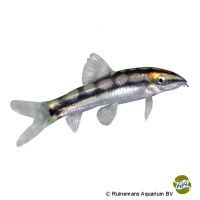Dwarf Chain Loach (Ambastaia sidthimunki)
| Dwarf Chain Loach Ambastaia sidthimunki | |
|---|---|
| Name | Dwarf Chain Loach |
| Name Lat. | Ambastaia sidthimunki |
| Synonym | Yasuhikotakia sidthimunki |
| Family | Pointface Loaches |
| Family lat. | Botiidae |
| Order | Carps |
| Order lat. | Cypriniformes |
| Origin | South Asia |
| Habitat | Tributaries |
| Diet | Omnivore |
| pH | 6.0-7.5 |
| Behavior | Peaceful |
| Keeping | Group |
| Care Level | Difficult |
| Reproduction | Egg scatterer |
| Breeding | None reported |
| Life Span | 8-12 years |
| Protection | No |
| Metric Units | |
| Size | 6 cm |
| Temperature | 24-28 °C |
| Hardness | 2-12 °dH |
| Aquarium | ~ 100 l |
| US Units | |
| Size | 2.5" |
| Temperature | 75-82 °F |
| Hardness | 36-214 ppm |
| Aquarium | ~ 25 gal |
Distribution and habitat
The distribution area of the checkerboard loach are tributaries of the Chao Phraya and the Mae Klong in Thailand. They live in shady, clear and slow flowing waters with dead wood, roots and foliage.
Maintenance
The aquarium should have dense planting, shady hiding places (roots, stones, caves), subdued light (floating plants), sufficient swimming space and a weak current. In order not to injure their barbels, a fine-grained substrate (sand, round gravel) is ideal, which can be covered with some foliage (e.g. sea almond leaves)
No ammonia, ammonium and nitrite should be detectable, the nitrate value should not exceed 100 mg/l. To ensure the water quality and oxygen content, a filter and heater adapted to the aquarium size is required, as well as lighting for the species-appropriate day-night rhythm of the animals.
Diet
The food supply consists of live food, such as snails, daphnia, mysis, artemia and mosquito larvae, which are also eaten in frozen form without any problems, plus commercially available frozen special food mixtures, supplemented with high-quality dry food (flakes, granules, tablets). In addition, they need regular vegetable food, such as zucchini, avocado, broccoli or scalded spinach, as well as dry food with high vegetable content (e.g. spirulina, kelp).
It is recommended to feed small portions several times a day. Only as much should be fed as is eaten immediately (in a maximum of 10 minutes). A regular and varied diet promotes health and increases resistance.
Behaviour and compatibility
They are sociable fish that can be well socialized in the group with not too small fish. Individually kept animals sometimes behave aggressively towards other fish. At least 5 checkerboard loaches should be kept together.
Basically, only compatible fish species with similar demands on water condition and water temperature should be socialized.
Sex dimorphism
There are no definite distinguishing characteristics. Adult females are slightly larger and rounder than males of the same age.
Reproduction and breeding
There are no known reports of successful breeding in the aquarium.
Important
They are mostly crepuscular and stay mostly hidden in caves or under rocks and roots during the day. The tank needs a good cover, because they jump occasionally
By rapidly sucking in and expelling water through their mouths, they can produce clearly audible cracking sounds that are probably important for territorial behavior. A strict hierarchy prevails within the group
The well-being of the fish should be monitored regularly. Temperature should be checked daily, pH, hardness and nitrate levels should be checked at least every 14 days. Regular partial water changes are recommended, even if the contaminant level has not yet reached the upper limit. Sudden changes in water quality should be avoided. Newly introduced fish must be accustomed slowly to the water in the aquarium.
Further literature can be found in your pet store.
References
Text: Werner Winter; Image: Ruinemans Aquarium B.V.
Source: BMELV (1998): Tierschutzgutachten - Haltung von Zierfischen (Süßwasser); RIEHL & BAENSCH (2006): Aquarien Atlas Bd. 1, Mergus Verlag; ENGELMANN (2005): Zootierhaltung - Tiere in menschlicher Obhut: Fische, Verlag Harri Deutsch
- Gemäß § 21 Abs. 5 Tierschutzgesetz idgF
